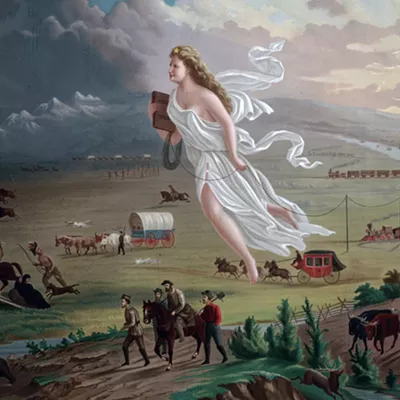When it comes to artistic expression, you've got a myriad of possible forms to explore. You've got your live music and live theater. You've got your visual art and performance art. You've got prose and poetry. And never, ever shall they meet, intersect or in any other way merge in the same performance at the same time, particularly in front of an audience. So sayeth the purist.
To those with a more freewheeling approach to the arts, however, all this artificial segregation of forms seems like a lot of hooey.
Andy Friedman is primarily a visual artist. He works in pen and ink and with photographic film. Yet the often staid and stilted gallery method of showing off his work left him deeply unsatisfied. What he envisioned was more of a rock 'n' roll approach. Friedman was hungry for the instant gratification that thespians and rock stars are afforded, that tangible connection with the audience that can only be attained through live performance. But how does one animate two-dimensional visual art in such a way to make it both intellectually stimulating and entertaining?
With a slide projector. With stream of consciousness monologues that ring poetic. With a respect for -- and a genuine desire to connect with -- the guy with the Miller High Life who paid his cover charge. Friedman has no guitar, doesn't claim to be a musician, yet he insists, "A performer needs only a true and heartfelt light to rock a crowd."
The 29-year-old Brooklyn performance artist is coming to rock our little corner of the world next Wednesday night with a show at Eichardt's Pub in Sandpoint. Eichardt's seems a perfect venue for Friedman, who typically shuns high falutin' concert halls and snooty galleries in favor of places with bar stools and smoky back rooms. It's in these environments that he finds the audiences, the people he's attempting to reach. And he wants nothing less than to drastically alter notions of "performance" forever.
"The reason I've been touring the nation's bars and music clubs for almost three years," he says, "is to bring a live, poetic forum to the visual arts."
Friedman's performances are a captivating mix of spoken lyrics set to a slideshow presentation of his drawings and photographs. It's an unholy union of beat poetry and travelogue. It works for him -- and for audiences all over the country who have witnessed the unique spectacle. Friedman has received favorable reviews in The New Yorker, The Boston Globe and in weeklies from San Francisco to Nashville. He's also recently been the subject of a BBC radio feature.
And at the end of each performance, patrons may purchase a copy of the artist's album. Only at this rock show, the "albums" are in soft cover. Friedman's second book, Future Blues (self-published on City Salvage Records) is a collection of Polaroid photographs and evocative ramblings about place, people and time. In it, he references traditional country blues and folk songs as he blends his photography and words.
"I'd been listening to a lot of interpreters," he says. "Musicians like Ry Cooder and Dave Van Ronk, who took old songs, turned them around, and presented something new in the composition. & ordm;I did the same, and the result was a book of pictures. It's about a guy who found his road, but is too busy driving on it to look out the window."
Slow it down, then. Look. Listen. And don't be surprised if your preconceptions are short-circuited, if not completely rewired.
Fill in the... Blanks -- The guys in Holfiller have this marketing thing down cold. They promote their shows with the zeal of a televangelist. They have a van emblazoned with their corporate logo. And like fashion maven Tommy Hilfiger -- from whom they lifted the band's original name (they were eventually forced to drop the "Tommy" part) -- they have their own apparel line with over 30 different items including T-shirts, hoodies, baseball caps, shorts and thongs. Oh, and they are a hard-rocking rock band, too, performing a show at the Big Easy Concert House this Saturday night (with locals Lucid and Soma) to benefit an injured friend, Spokane stunt cyclist Tommy "Gun" Wyant.
The Seattle-based Holfiller consists of guitarists Jason Pilalas and Rob Murphy, vocalist Josh Baker, drummer Tom Rentfro and bassist Marty Meisner. (Meisner, you recall, was the bassist for the Mayfield Four.) The band originally formed in 1997 and has since released one EP and two proper albums (Nymphomercial EP in 1999, The Hole Story in 2000 and Holfiller 2003 in -- yep -- 2003). They've also been pounding the pavement, landing gigs all over the Northwest.
Instead of "live fast, die young" as a motto, the Holfiller guys ascribe to a "do it big or don't do it at all" modus operandi. That attitude occasionally gets them in trouble (Holfiller's once very raunchy stage show tended to draw the ire of law enforcement), but usually never fails to get them noticed. And that, arguably, is what it's really all about. -- Mike Corrigan
Believe in the Backbeat -- Back then, he was younger than the Young Lions. But Eric Reed has his own pride now.
Reed was a largely self-taught child phenom of jazz piano before Wynton Marsalis hired him in 1989, replacing Marcus Roberts. Back then, Marsalis was just 28; Reed was only 19.
Young Reed proceeded to play on several of Wynton's recordings, including the Sunday church-service album of 1993, In This House, on This Morning, and the 1995 Pulitzer-winning slavery epic, Blood on the Fields.
As a leader, however, Reed has broken away to record a dozen albums since 1990, several of them thematic. In 2003 alone, he recorded Christmas songs (Merry Music), gospel tunes (Mercy and Grace) and an electrified approach to mainstream jazz (E-Bop). In 1999, he released jazz meditations on his New York, New York experiences, Manhattan Melodies.
As a black man, a devout Christian and a jazz pianist, Reed must feel the pressure of being in the minority a lot. Isn't it difficult to be a Christian in the jazz world?
"It's hard in any world," he immediately replies. "The Bible explains that there will be trials and tribulations everywhere you turn. It's like that cartoon with the good angel on one shoulder and the bad one on the other - there's a struggle between good and evil everywhere."
Reed's cell phone cuts out - he's speaking from his New York apartment - and then we get cut off altogether. When we reconnect, he answers with "Well, the devil just doesn't want this conversation to continue."
Reed will perform at Whitworth College on Saturday night. Despite having carried on the acoustic jazz tradition identified with Marsalis by teaching all over the world, Reed has never conducted a clinic at a Christian school before. "It was an afterthought, to be honest," he admits. "I was just pumped for a gig."
What kind of advice will be offer to student musicians? "Be attentive to the history of jazz," Reed responds. "Focus on that and know it, so that when you come out and play with big-time musicians, you'll be able to swing."
During Saturday night's concert, Whitworth senior jazz pianist Erik Hjelt will play a duo with Reed; the two pianists will decide on the spur of the moment what to play. Many musicians aren't especially articulate about how onstage improvisation works, but Reed is forthcoming on the topic: "There's a lot of eye contact," he says. "I may throw up a finger -- or if I stick out my thumb like I'm hitchhiking, that means 'Go back to the top.' Or I may show four fingers - that could mean four more chords, or 'Walk four beats and then resume,' or 'Trade fours, back and forth' - that means I take four bars, then you take four. Or I'll just play a musical idea, put it out there. But the best communication is the kind that takes place spontaneously."
On Saturday night, Reed will be communicating with the 18-piece Whitworth Jazz Ensemble, led by Dan Keberle. After Keberle leads the ensemble through a half-dozen big band tunes, Reed will join the band after intermission for selections from a menu of Keberle arrangements, standards such as "Don't Get Around Much Anymore," Dizzy's "A Night in Tunisia" and Bill Evans' "Peri's Scope."
Everyone in jazz piano has come under Evans' influence, and Reed agrees: "He's beautiful. But you know, I'm kinda disappointed in him, that he didn't compose more. I mean, he composed quite a few tunes, but not on the volume of Bud Powell or Duke Ellington. He certainly had the skill."
"Peri's Scope" is the only original on Evans' 1960 release, Portrait in Jazz, and there's some great interplay with Scott LaFaro on bass in that studio album, one of two just before the famous Village Vanguard recordings . . . but Eric Reed is not about to be outdone on jazz history. He's been attentive to the tradition: "Now, Portrait, that's a nice transitional album. Do you know Live at the Half Note, those bootleg tapes? I'll make you a copy and bring it out, man. That was just before Explorations. They were just a regular 4/4 trio, and then blam! -- they busted right out of that. You wouldn't know it was the same group."
It's the teacher in Reed flashing out for a moment. And his teaching is based on having played with some of the greats of jazz piano: He mentions, for example, Ahmad Jamal, the post-bop pianist most famous for "Poinciana" in the late '50s - "such a disciplinarian," says Reed, "a cool man." And Horace Silver and McCoy Tyner - "both gentlemen, both very sophisticated and even-keel."
You get the sense in speaking to him that Eric Reed - Wynton's prot & eacute;g & eacute;, jazz clinician, a leader in mainstream jazz - like his heroes, is sophisticated, disciplined and meticulous. Even if the devil is in the details (and the static). -- Michael Bowen
Publication date: 11/04/04















